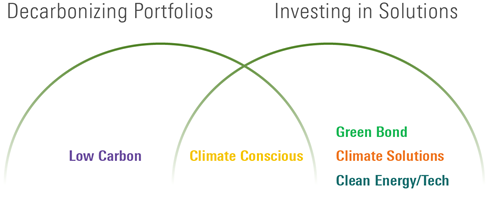
Despite the vast green landscapes seen across our beautiful country, the Canadian bond market is not known for its green thumb. In fact, a 2020 study by the Climate Bond Initiative indicated that of the Canada accounted for only 28% of the USD119.7 billion climate-aligned outstanding bonds in North America. Although we have seen continued growth in the market, the opportunity set for Canadian investors to green-up their bond portfolio remains somewhat constrained.
Where to Find Shades of Green in Bonds
When considering any sustainable investment option, investors need to balance their personal values with their financial goals. Certainly, climate-related investments would benefit from the consideration of both. The nuanced nature of climate-related investments warrants a consideration of the various options available.
To help with this endeavor, Morningstar’s recent Investing in Times of Climate Change 2022 report identified five mutually exclusive categories: Low Carbon, Climate Conscious, Green Bond, Climate Solutions and Clean Energy/Tech.
Climate Strategies and Their Role in Portfolios

Source: Morningstar Research
The analysis excluded fossil-free mandates as many strategies have fossil-related exclusions, but do not brand themselves as such. We also excluded low carbon mandates that seek to maintain a lower carbon intensity than a benchmark without identifying clear reduction targets.
For Canadian bond investors, the opportunity set includes funds from only three of these categories:
- Low Carbon: These are funds that seek investments in companies with reduced carbon intensity or footprints relative to a representative benchmark. Importantly, these funds also disclose their measurable targets allowing carbon emissions to be tracked and monitored.
- Climate Conscious Funds: These are funds that select or tilt towards investments where climate change is considered in their operations, making them better equipped to transition to a lower-carbon economy. Portfolios tend to be fairly diversified across a variety of companies that either positively align with transition or provide climate solutions to others.
- Green Bond Funds: These are funds that invest in bonds where proceeds are allocated towards projects aimed at facilitating the transition to a green economy. The bonds held in these portfolios can be issued by companies or governments and have generally satisfied a set of standards or criteria outlined by a regulatory body. Also included in this category are transition bonds, a relatively new class of bonds aimed at helping companies transition towards a reduced environmental impact, or to reduce their carbon emissions. Unlike green bonds, these initiatives are not required to be green, but must be geared towards improving a company’s sustainable business practices. Transition bonds are currently unregulated, though Canada recently announced a Green Bond Framework that is aligned with international green bond principles.
Climate-Friendly Bonds in Canada
Only 3 of 5 Climate categories contain climate bond strategies available to fund investors in Canada, reflecting the relatively small number of climate bond funds available in our market. Although the space is growing rapidly, our study identified less than 30 climate funds available to Canadians, of which only 7 were fixed income funds.
Most of these funds are relatively new, with five of the seven being launched in either 2021 or 2022. These newer strategies now account for over 50% of assets in climate-friendly bond funds, signaling interest and demand from investors. Furthermore, it is promising to see that these funds earn relatively high Morningstar Sustainability Ratings. These ratings are meant to indicate a fund’s exposure to material ESG risk with higher ratings indicating lower risk.
The Desjardins RI Active Canadian Bond Low CO2 ETF is the only fund focused exclusively on the Canadian bond market. Five of the seven funds are considered Green Bond products, indicating their emphasis on bonds that adhere to some form of regulation or standard.
Although this aligns investors’ investments with climate-oriented projects, there are some risks to consider. In July 2021, Morningstar released a Green Bond Landscape report that discussed the tendency for the asset class to have lower liquidity and higher valuations than traditional asset classes. This means investors with shorter term investment horizons may not find the asset class appropriate for their financial needs. Similarly, the infancy of the asset class warrants some caution around expectations for full market cycle performance.
Like the coming of a Canadian spring, the crop of Canadian climate bond funds is showing signs of sprouting. Fund companies with notable strength in bond investing are starting to focus their expertise on climate-oriented strategies resulting in a greater selection for Canadian bond investors. As the available options continues to grow, interest in the asset class should continue to be paired with caution given some of the unproven aspects it brings.




















